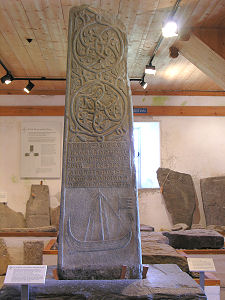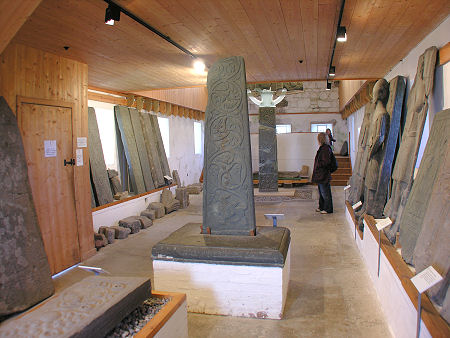 Iona Abbey Infirmary Museum, Looking West |
Since this page was written and the photographs for it taken, the stones in the Infirmary Museum have been completely redisplayed. As a result the rest of this page is out of date, as are the images used to illustrate it. It will be updated as soon as we have been able to revisit the museum.
One of the really beautiful things about a visit to Iona Abbey is its almost complete lack of commercialisation. There is an abbey shop, but you have to look for it: and there are no intrusive signs telling you to go this way to the abbey church or that way to the cloister. You are left free to explore, and to discover this wonderful place for yourself, at your own pace.
There is a one slight downside to this. If you are the sort of person who buys the guidebook on arrival, but only reads it after departure, it is perfectly possible to leave Iona without seeing one of its greatest treasures. Just to the north-east of the main body of Iona Abbey is a detached building that once probably served as the monks' infirmary.
Today the Infirmary serves as a museum and is home to one of the finest collections of stone crosses, slabs and grave markers you are likely to find anywhere in Scotland. Most of the exhibits are native to Iona, either coming from the ancient graveyard serving Iona Abbey at Relig Odhráin, or are stone crosses placed at various points around the island as prayer-stations for pilgrims to the island.
They were moved to the museum to counter concerns that if left exposed to the elements, these beautiful and remarkable artefacts would eventually erode away to illegibility. We've discussed elsewhere our doubts about the removal of grave markers from graveyards without replacing them with replicas: but this in no way detracts from the value of preserving the originals for future generations in a safe environment like the Infirmary Museum.
The exhibits in the museum fall into three main categories. Most spectacular are the stone crosses, in most cases reconstructed from the pieces that were all that remained when the 8th Duke of Argyll started to take an interest in what was then the ruin of Iona Abbey in the late 1800s.
One end of the museum is dominated by St John's Cross. This was carved some time between 750 and 800, but the ambitious design, with wide cross arms was unable to stand up to Ionan winds, and the cross collapsed soon after it was erected. It was later re-built with a circular stone support linking together the cross arms and the shaft, producing a design that went on to be widely copied. Today a replica of St John's Cross stands in front of the abbey, while what you see in the museum is what remains of the original.
At the other end of the museum is St Oran's Cross, the earliest of Iona's stone crosses. At present its pieces lie displayed horizontally, but it is hoped eventually to restore it to an upright position, allowing the carving on both its sides to be appreciated. Nothing sadly remains of 357 other stone other crosses on Iona that were destroyed as a result of the Reformation of 1560.
The second category of exhibits in the museum covers the large number and wide selection of beautifully decorated grave slabs, most of which were brought here from the nearby Relig Odhráin. These range from a number with abstract geometric patterns to a superb group carrying exquisitely defined images of knights in armour.
One of these effigies is known to be of Gilbride MacKinnon, and commemorates five generations of his family. Gilbride is shown in full armour and carrying a spear and a sword, and the memorial was probably commissioned by his great-grandson, Finguin, who served as Abbot of Iona at the end of the 1300s.
The final category of exhibit covers a range of other, often partial or fragmentary, pieces of carved or worked stone. Perhaps the most famous of these, complete with its own display-cage, is Columba's Pillow. This is said to have served as St Columba's gravestone, after being used by him, literally, as a pillow during his lifetime.
The style of carving of a cross on the stone dates from 200 years after St Columba's time, but this can be seen either to call into doubt the alleged origins of the stone, or to support them, with the stone being regarded as so important it was carved with a cross 200 years after being used by St Columba. Elsewhere in the museum you come across a stone that looks exactly like, but probably isn't, a medieval crossword puzzle.
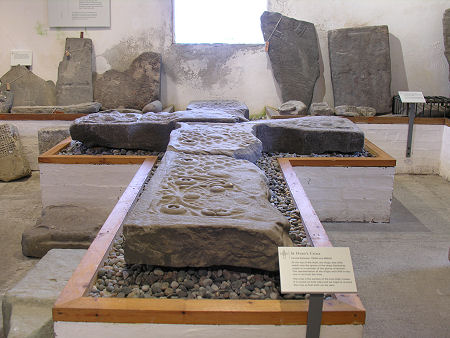 St Oran's Cross |

|
|
|
Visitor InformationView Location on MapThe Infirmary Museum forms part of Iona Abbey. Full Visitor Information here. What3Words Location: ///norms.aboard.loans |
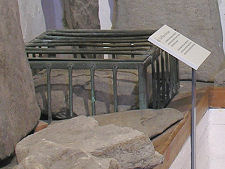 Columba's Pillow |
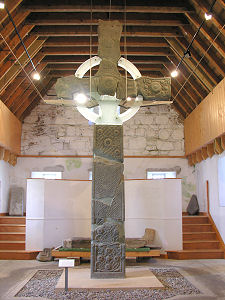 St John's Cross |
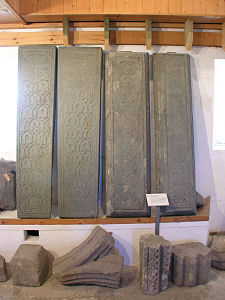 Highly Decorated Grave Markers |

